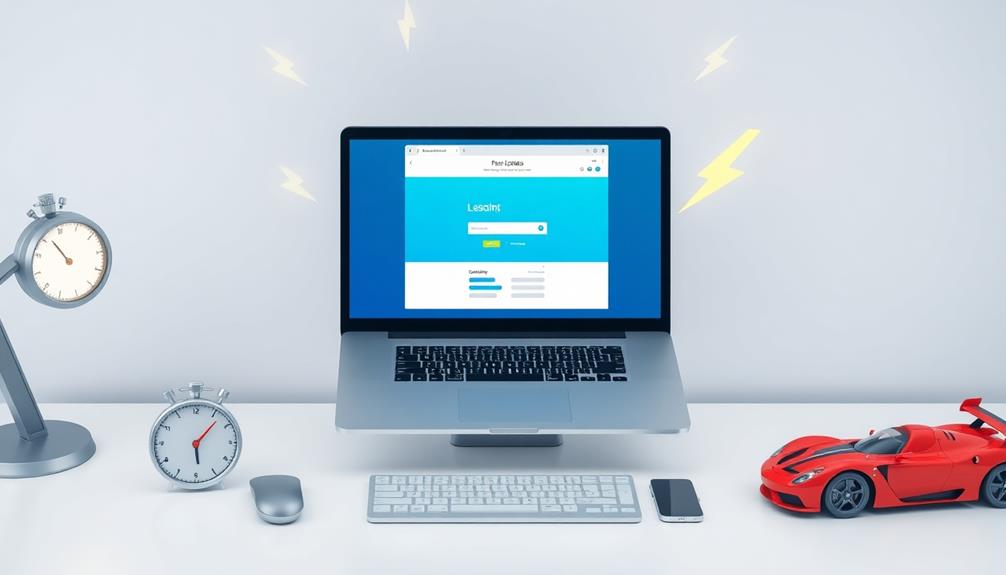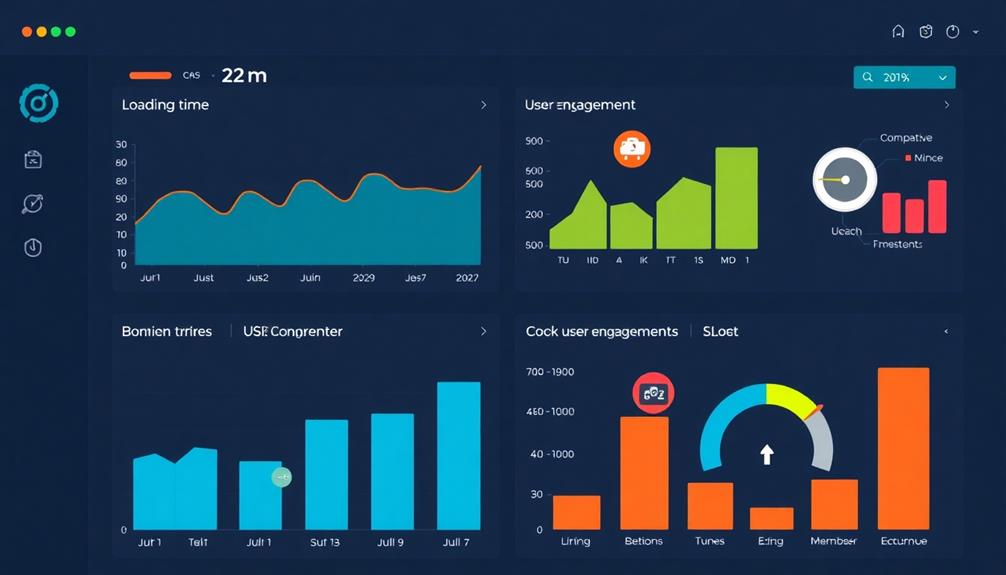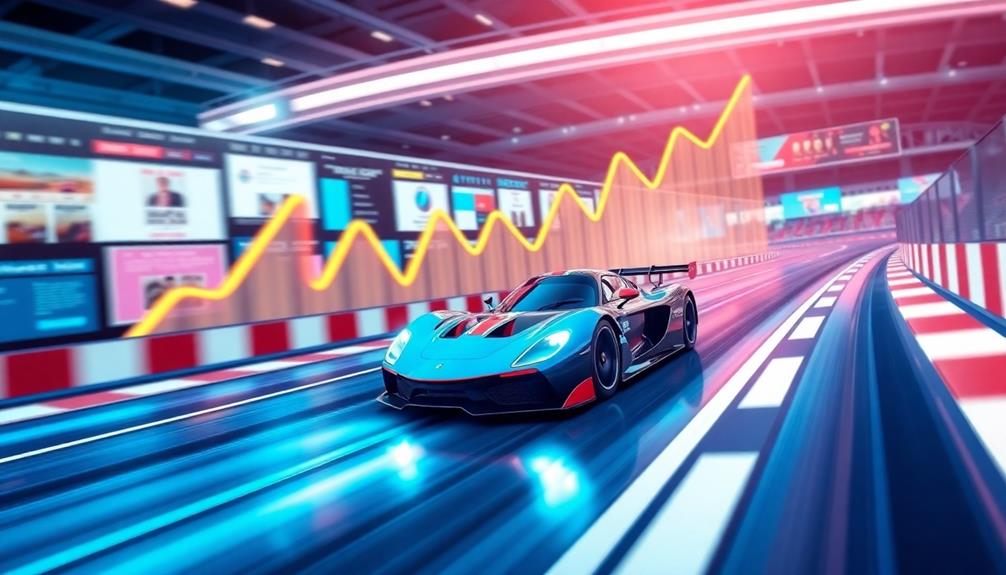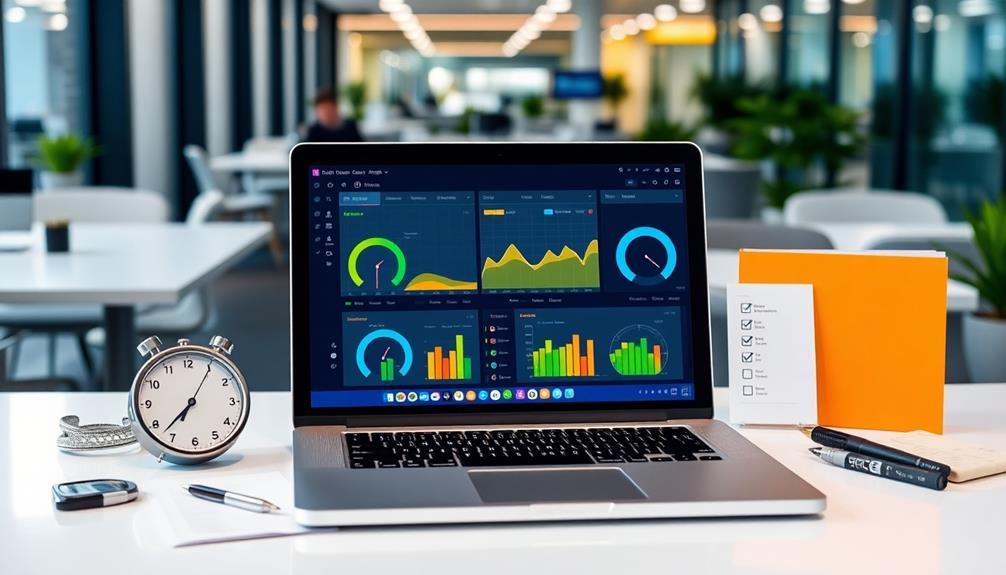To increase your website speed, focus on optimizing images, using efficient caching methods, and minifying code. Compress images with formats like WebP and implement lazy loading to reduce initial load times. Caching stores static versions of your pages, enhancing user experience, while code minification cuts unnecessary characters from CSS and JavaScript. Fast websites matter because delays of just one second can lead to a 7% drop in conversions and increased bounce rates. Plus, Google prioritizes speedy sites for better search rankings. If you want to discover more effective strategies, keep going!
Key Takeaways
- Optimize images using modern formats and lazy loading to reduce file sizes, enhancing initial load times significantly.
- Implement efficient caching methods to store static versions of web pages, improving load times for returning visitors.
- Minify and aggregate CSS and JavaScript files to reduce HTTP requests and improve overall site responsiveness.
- Regularly monitor performance using tools like Google PageSpeed Insights to identify and address bottlenecks.
- Fast-loading websites improve user satisfaction, conversions, and SEO rankings, leading to greater brand loyalty and revenue.
Importance of Website Speed

When you consider the online experience, website speed emerges as a critical factor that can make or break user engagement. A staggering 47% of users expect a page to load in 2 seconds or less. If your page load time stretches beyond that, you risk losing potential customers. In fact, just a 1-second delay can lead to a 7% drop in conversions. This means that if your site isn't fast, you're leaving money on the table.
Incorporating elements like natural elements for a calming workspace can also enhance user experience by creating a more inviting atmosphere.
High website performance isn't just about keeping users happy; it also impacts your search engine rankings. Google prioritizes fast-loading sites, so improving your page load time can boost your visibility online.
Research shows that bounce rates soar by 32% when loading times increase from 1 to 3 seconds, and there's a staggering 90% chance users will bounce if your page takes 5 seconds to load.
Moreover, fast-loading sites foster trust and professionalism, which are essential in a competitive digital landscape. By focusing on website speed, you enhance user experience and retention rates, ultimately driving your business's success.
Don't underestimate the importance of website speed; it can truly make a difference.
Key Metrics for Speed

Website speed isn't just about user perceptions; it can be quantified through specific metrics that highlight performance. Understanding these key metrics will help you gauge and improve your website's speed effectively.
| Metric | Ideal Value | Purpose |
|---|---|---|
| Time to First Byte (TTFB) | Under 0.8 seconds | Measures server responsiveness |
| Largest Contentful Paint (LCP) | Under 2.5 seconds | Evaluates loading performance of the largest element |
| Total Blocking Time (TBT) | Under 200 milliseconds | Tracks main thread blockage for interactivity |
| First Contentful Paint (FCP) | Under 1.8 seconds | Indicates when the first content is visible |
| Cumulative Layout Shift (CLS) | Under 0.1 | Assesses visual stability during loading |
Regularly monitoring these metrics with tools like Google PageSpeed Insights and GTmetrix is essential. By doing so, you can identify performance bottlenecks and track improvements over time. Focusing on these metrics not only enhances your website's speed but also contributes to overall user satisfaction.
Impact on User Experience

A site's speed greatly affects user experience, shaping how visitors perceive and interact with your content. Users expect a webpage to load in 2 seconds or less; if load times exceed this threshold, about 47% of users will bounce. This highlights the critical importance of page speed for retaining visitors.
Even a 1-second delay can reduce user satisfaction and engagement, leading to a 7% drop in conversions. Understanding common financial terms can also help website owners better convey their value proposition effectively. Research shows that when load times extend from 1 to 3 seconds, bounce rates can increase by 32%.
Fast-loading websites not only keep users on your page but also build customer satisfaction and brand loyalty. Users often equate speed with professionalism and reliability, making a quick-loading site crucial for a positive user experience.
If your site takes 5 seconds or longer to load, you risk losing up to 90% of users. It's important to optimize your site's performance to maintain interest and engagement.
Conversion Rate Benefits

Improving page load times consistently boosts conversion rates, making speed a pivotal factor in your site's success. A mere 1-second delay in page load time can lead to a staggering 7% reduction in conversions.
If you want to maximize sales, aim for a load time of 0-4 seconds, as this range typically sees the highest conversion rates. Regular monitoring and adjustment of production plans can help guarantee your website performance aligns with user expectations.
Research shows that 47% of users expect your page to load in 2 seconds or less. If you don't meet this expectation, you risk increasing bounce rates, which means potential customers leave your site before making a purchase.
This is a costly mistake, especially when you consider that Amazon could lose $1.6 billion annually due to just a 1-second slowdown in loading times.
Faster page load times not only enhance user experience but also improve customer satisfaction. This leads to greater brand loyalty and encourages repeat visits, both of which are essential for sustained conversion growth.
SEO Implications

Recognizing the importance of page speed is essential for your site's SEO success. Google considers page speed a significant ranking factor, so if your site loads slowly, you might see a drop in visibility and organic traffic.
AI-driven solutions can help optimize your website's performance, allowing for faster load times. Here's how page speed directly impacts your SEO:
- Bounce Rate: Longer load times lead to higher bounce rates. A study found that as load times increase from 1 to 3 seconds, bounce rates can rise by 32%. If your site takes longer than 5 seconds to load, there's a 90% chance visitors will leave.
- User Experience: Faster loading pages enhance user experience, which not only keeps visitors on your site longer but also encourages them to explore more. A better experience can lead to improved SEO rankings.
- Search Engine Rankings: Optimizing your page speed can positively influence your search engine rankings. The quicker your site loads, the more likely it's to rank higher in search results, attracting more traffic.
In short, prioritizing page speed is essential for reducing bounce rates and boosting your search engine rankings.
Don't overlook this important element of your SEO strategy!
Best Speed Optimization Techniques

To boost your website's speed, focus on image compression strategies, efficient caching methods, and code minification.
Additionally, consider optimizing your website's color accuracy to guarantee that images load faster without sacrificing quality.
These techniques can greatly cut down on load times and enhance user experience.
Let's explore how to implement each of these methods effectively.
Image Compression Strategies
A well-tuned image can be a game changer for your website's speed and performance. By focusing on effective image compression strategies, you can greatly enhance your site's loading times and user experience.
In today's digital landscape, where over 70% of Americans apply for credit cards online, a fast-loading website can improve customer satisfaction and conversion rates. Here are three essential techniques to take into account:
- Use Modern Formats: Switch to formats like WebP, which can compress images without sacrificing quality. This can reduce file sizes by up to 85%, leading to faster load times compared to older formats like JPEG and PNG.
- Implement Lazy Loading: Enable lazy loading to guarantee images only load when they're visible in the viewport. This reduces the initial page load time, improving usability and keeping visitors engaged.
- Automate Compression: Utilize tools like TinyPNG or ImageOptim to automate the image optimization process. Automating this task helps maintain ideal file sizes without needing constant manual intervention.
Regularly auditing your images and removing unnecessary large files can also contribute to a lighter page weight.
Prioritizing these image compression strategies will drastically improve your website's speed and overall performance, especially in an era where credit card fraud protection is paramount for online transactions.
Efficient Caching Methods
Efficient caching methods are vital for enhancing your website's speed and overall performance. By storing static versions of web pages, you can greatly reduce load times, leading to faster Time to First Byte (TTFB) and an improved user experience.
Implementing browser caching allows frequently accessed resources, like images and stylesheets, to be stored locally on users' devices. This decreases the need for repeated downloads, making return visits smoother. Additionally, choosing ideal web solutions can reflect the same benefits seen in high-performance units rated for extreme temperatures.
On the server-side, techniques such as page caching and object caching can reduce server load. By serving pre-generated content, you enhance server response times, making sure users get what they need quickly.
Additionally, utilizing a Content Delivery Network (CDN) can further enhance caching. A CDN distributes copies of static content geographically, allowing users to access the nearest server, which leads to faster load times.
However, don't forget that regularly clearing and managing your cache is essential. This practice guarantees that users receive the most up-to-date content while still maintaining ideal site speed.
Minification and Code Optimization
Improving website speed goes beyond just caching; minification and code optimization play a key role in enhancing performance.
As AI technology continues to grow, with market projections indicating a notable increase in adoption (AI integration in smartphones), optimizing your website becomes even more vital to keep up with user expectations.
By reducing file sizes, you can considerably improve loading times for your users. Here are three steps to help you optimize your site effectively:
- Minification: Remove unnecessary characters, comments, and whitespace from your CSS, JavaScript, and HTML files. Tools like CSSNano and UglifyJS can automate this process, making it easier for you.
- Combine Files: Merge multiple CSS and JavaScript files into single files. This minimizes HTTP requests, allowing your server to respond faster and improving overall page load times.
- Defer JavaScript: Reduce render-blocking JavaScript by deferring non-essential scripts. This guarantees your main content loads quickly, so users can interact with your site sooner.
Don't forget to utilize tools like Autoptimize for automating minification and aggregation.
Finally, regularly test your page performance after implementing these optimizations to confirm your loading times stay under the recommended 3 seconds.
Following these steps won't only enhance user experience but also contribute to better SEO rankings.
Tools for Performance Testing

When it comes to optimizing your website's speed, various tools for performance testing can make a significant difference. One essential aspect of enhancing your site's performance is guaranteeing high-quality content, which not only boosts credibility but can also positively impact load times importance of content quality.
One of the most valuable resources is Google PageSpeed Insights, which evaluates your website performance and gives you a score from 0 to 100. This tool not only highlights speed quality but also offers actionable recommendations to improve your site.
Another excellent option is GTmetrix, which combines insights from Google PageSpeed and YSlow. It allows you to analyze performance across devices and provides detailed visual reports, helping you pinpoint optimization opportunities.
Pingdom is also useful, as it tracks performance history and grades your website, enabling you to understand load times and identify any bottlenecks.
Lastly, YSlow offers performance improvement suggestions based on predefined rules for high-performing sites, helping you measure and enhance loading efficiency.
Regularly using these tools is essential for tracking key performance metrics like Time to First Byte (TTFB) and page load time. This ongoing analysis guarantees your optimization efforts align with user expectations and technological advancements, ultimately leading to a faster, more efficient website.
Common Speed Optimization Mistakes

When it comes to speed optimization, you might be making some common mistakes that can seriously hinder your site's performance.
For instance, ignoring image compression can lead to unnecessarily large file sizes, which slow down loading times.
Additionally, using too many plugins, especially those that aren't optimized, can add bloat to your site.
Neglecting caching strategies can also contribute to slower load times and frustrated visitors.
To guarantee a smoother experience, consider implementing website optimization techniques that enhance speed.
Let's take a closer look at how to avoid these pitfalls and boost your website's speed.
Ignoring Image Compression
One of the biggest pitfalls in website speed optimization is neglecting image compression. When you ignore this vital step, your images can balloon in size, leading to slower page load times.
Studies show images can account for up to 60% of a webpage's total weight, so optimizing images is essential for enhancing your site's performance.
Here are three effective strategies to help you compress your images:
- Use Compression Tools: Tools like TinyPNG or WP Smush can reduce image file sizes by up to 85%, considerably improving loading times.
- Choose Modern Formats: Serve your images in formats like WebP, which provide better compression and quality compared to traditional JPEG or PNG files.
- Implement Lazy Loading: This technique delays loading images until they're needed, preventing unnecessary data from slowing down initial page load times.
Excessive Plugin Usage
Excessive plugin usage can be a silent killer of your website's speed, causing significant resource consumption that ultimately leads to sluggish performance.
Each additional plugin you add can increase HTTP requests, which collectively contribute to longer load times. In fact, performance tests show that certain plugins can slow down websites by as much as 50%.
This means that your page speed may suffer, potentially causing a 1-second delay that reduces conversions by 7%.
To improve your website, regularly audit your installed plugins. Identify and remove unnecessary or poorly optimized plugins to enhance page speed and user experience.
Aim to keep your load times ideally under 3 seconds. By limiting the use of plugins to only those essential for functionality, you not only boost site speed but also enhance security by reducing the risk associated with outdated or poorly maintained plugins.
Neglecting Caching Strategies
Neglecting caching strategies can greatly hinder your website's performance. Without effective caching, you'll face increased server load and slower response times, which can directly impact your Time to First Byte (TTFB). This can lead to a poor user experience, driving visitors away.
Here are three key reasons to prioritize caching:
- Faster Load Times: Implementing caching can improve page load speeds by up to 50%, making your site much more responsive for users.
- Resource Efficiency: Browser caching allows users to store elements like stylesheets and scripts locally, reducing the need to reload these resources each time they visit.
- Traffic Management: During traffic spikes, caching helps manage requests efficiently, preventing potential downtime and protecting your revenue, especially on e-commerce sites.
Long-term Speed Strategies

Sustaining ideal website speed requires a well-defined long-term strategy that includes regular performance audits. You should regularly assess your site's performance to identify bottlenecks and track improvements, guaranteeing that loading times consistently meet benchmarks like a TTFB under 0.8 seconds.
Establish specific performance goals tied to key metrics, such as aiming for a page load time under 3 seconds. Remember, 47% of users expect pages to load in 2 seconds or less.
Continuously monitor user feedback and site analytics to adapt your speed optimization efforts based on real-world user experiences and traffic patterns. To support this strategy, utilize a CDN and effective caching tactics to guarantee content delivery remains efficient, particularly during traffic spikes.
This will help you maintain peak performance as your site scales.
Lastly, stay informed about industry trends and new optimization techniques. Incorporating the latest best practices not only enhances overall site speed but also helps you maintain a competitive edge.
Future Trends in Website Speed

As you implement long-term strategies to optimize your website speed, it's essential to keep an eye on future trends that can shape your approach. Staying ahead of these trends guarantees that your website remains competitive and user-friendly.
- Core Web Vitals: As Google continues to prioritize metrics like Largest Contentful Paint (LCP) and Cumulative Layout Shift (CLS), focusing on these will be critical for maintaining and improving your search rankings.
- 5G Technology: The rollout of 5G is set to revolutionize mobile website speed, potentially bringing load times under 1 second. This could dramatically enhance user experiences on mobile devices, making it necessary to optimize sites for this new standard.
- AI-Driven Optimization Tools: Emerging AI-driven tools are offering real-time adjustments based on user behavior, allowing for a more personalized and efficient web experience.
Leveraging these tools will help you stay adaptive to traffic patterns.
Frequently Asked Questions
Why Does Website Speed Matter and How to Improve It?
Website speed matters because it directly impacts user experience and conversion rates. To improve it, optimize images, reduce HTTP requests, and leverage caching. Regularly monitor performance to keep your site fast and engaging for visitors.
What Is Page Speed and Why Is It Important?
Page speed is the time it takes for a web page to fully load. It's essential because slow pages frustrate users, leading to higher bounce rates, decreased conversions, and ultimately, lower revenue for your business.
How to Boost Website Speed?
Think of your website as a race car. To boost its speed, compress images, implement browser caching, minify files, leverage a CDN, and conduct regular audits. You'll leave competitors in the dust!
What Does the Speed of a Website Depend On?
The speed of a website depends on resource size, network conditions, hosting solutions, and web technology complexity. You'll notice that larger files and inefficient plugins can greatly slow down your site's loading time.
Conclusion
To sum up, boosting your website speed isn't just about numbers; it's about enhancing user experience and driving conversions. Think of your site as a car—if it's slow, visitors will hit the brakes and look elsewhere. By focusing on key metrics and avoiding common pitfalls, you can create a smoother ride. Embrace ongoing speed strategies to stay ahead of trends, ensuring your site remains fast and user-friendly. After all, a quick website keeps users coming back for more.










